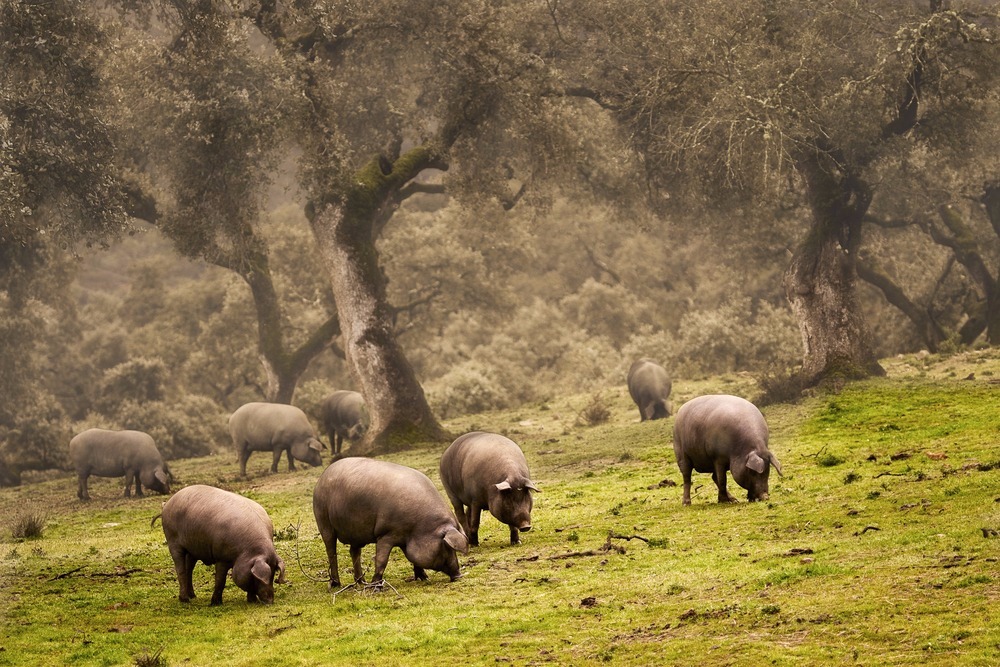We’re spilling the beans about the rooted tradition of the Spanish ham in Andalucia.
The wafer-thin Spanish ham slices are every Andalucia’s bars and restaurants’ star dish. There are countless ways to relish the Jamón Ibérico’s taste, and Andalusians know them all. So, if you want to engage in a five-sense experience, go on reading and forget about the motto “ignorance is bliss”.
What is Spanish ham?
Spanish ham is an artisanally cured ham that characterises the Spanish cuisine. One can identify two main types, based on the pigs’ diet and the length of the curing process:
- the Jamón Serrano. This ham variety is the most spread, covering 90% of cured ham production in Spain. It comes from conventional pigs fed on cereals, and it is available after 12-to-18 months of curing.
- the Jamón Ibérico, on the other hand, is the star of Spanish ham. It is also known as “pata negra” (black leg) because it comes from a peculiar Iberian pig species, whose most noteworthy features are the black hooves. The curing of this variety of ham can last up to 2 years, producing a low-fat, intense-flavoured, ruby red ham.
Which is the best Spanish ham?
The best Spanish ham is considered to be the DO (Denomination of Origin) Jabugo Jamón Ibérico, from Huelva province. This variety is made from pigs that roam free in the forests and slowly feed exclusively on oak acorns. Those pigs that gain half of their weight (160kg) by eating only acorns produce the healthiest, most organic ham Jamón Ibérico de Bellota, also known as Cinco Jotas (JJJJJ). This name comes from the highest punctuation that can be awarded to the Spanish ham, a kind of five-star classification that goes from one to five Jotas.
A curiosity: the pigs, from which the Jamón Ibérico de Bellota is made, are known as “olives with feet“, as the quality of their fat is as healthy as that of the virgin olive oil.

Furthermore, there are three more areas in the Iberian Peninsula where the DO Spanish ham comes from: Salamanca in the north, and Valle de Los Pedroches and Extremadura in the east.
How is Spanish ham made?
The process of curing is substantially composed of spreading a specific quantity of salt (10/15 cm per each metre of the ham piles’ height) on the ham and let it absorb (1 day per each kg) while leaving the meat dry in a climate-checked environment. The length of this process and the personalised attention given to it are fundamental criteria the DO inspectors rate. When such requirements are met, the ham receives the DO tag.
Why is Spanish ham so expensive?
Some may think that the Spanish ham costs an arm and a leg. And they are not entirely wrong, to tell the truth. However, being known as the best ham in the world, you can’t expect to spend the same for the Cinco Jotas and for the one you buy at the groceries’ near home, can you? As a matter of fact, some varieties reach the astronomical cost of €400/kg.
How to eat Spanish ham?
There exists no rule to relish the Spanish ham. However, one of the best ways is with recently-made bread and a sip of extra-virgin olive oil. An explosion of flavour will inundate your mouth, as this food experience converts into a bliss of senses. Once you’ve tried this, you can rejoice other recipes that have the Spanish ham as (one of) the main ingredients. Among them, you can’t miss out on the Cordoban Salmorejo and the croquettes.
Where to buy the Spanish ham?
Given that the best Jamón Ibérico is the one you enjoy in the Andalusian bars and restaurants, you may also want to relive this ecstasy at home. To do so, you can check the Maximiliano web page, a Jabugo-producing company that sends ham products to EU countries; the Juan Pedro Domecq web page or the US company La Tienda web page.
Don’t leave Andalucia before you’ve tasted the mouth-watering Spanish ham.
Have you already tried the Spanish ham? Which variety is your favourite one? Tell us in the comments below!






